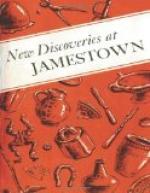Timber at Jamestown was plentiful, so many houses, especially in the early years, were of frame construction. During the first decade or two, house construction reflected a primitive use found ready at hand, such as saplings for a sort of framing, and use of branches, leafage, bark, and animal skins. During these early years—when the settlers were having such a difficult time staying alive—mud walls, wattle and daub, and coarse marshgrass thatch were used. Out of these years of improvising, construction with squared posts, and later with quarterings (studs), came into practice. There was probably little thought of plastering walls during the first two decades, and when plastering was adopted, clay, or clay mixed with oyster-shell lime, was first used. The early floors were of clay, and such floors continued to be used in the humbler dwellings throughout the 1600’s. It can be assumed that most of the dwellings, or shelters, of the Jamestown settlers, certainly until about 1630, had a rough and primitive appearance.
After Jamestown had attained some degree of permanency, many houses were built of brick. It is quite clear from documentary records and archeological remains, that the colonists not only made their own brick, but that the process, as well as the finished products, followed closely the English method. Four brick kilns were discovered on Jamestown Island during archeological explorations.
[Illustration: An early Jamestown house. (Conjectural sketch by Sidney E. King.)]
[Illustration: A brick house at Jamestown, about 1640. (Conjectural sketch by Sidney E. King.)]
[Illustration: The majority of the locks and keys used in the early houses were imported from England.]
[Illustration: A few 17th-century handwrought hinges in the Jamestown collection.]
BUILDING HARDWARE
While some of the handwrought hardware found at Jamestown was made in the colony, most of it was imported from England. Types of building hardware unearthed include an excellent assortment of nails, spikes, staples, locks, keys, hinges, pintles, shutter fasteners, bolts, hasps, latches, door knockers, door pulls, footscrapers, gutter supports, wall anchors, and ornamental hardware. In many instances each type is represented by several varieties. Citing 2 examples, there are more than 20 kinds of nails and at least 15 different kinds of hinges in the collection.
[Illustration: Some nails, spikes, staples, and other iron hardware used at Jamestown over 300 years ago.]
[Illustration: Some Jamestown houses had leaded glazed wrought-iron window casements similar to the ones Shown here. (Courtesy, The Metropolitan Museum of Art, New York.)]




